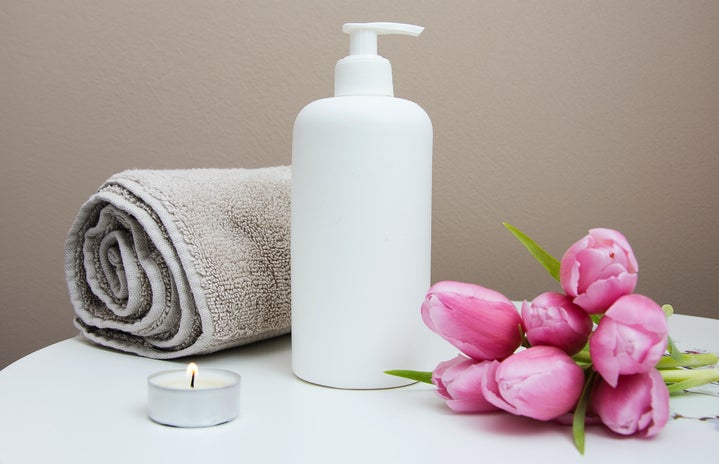Our pores might already secrete a natural oil that would make dining hall pizza jealous, so it’s too bad we can’t use our sebum as a self-serving facial cleanser. However, there’s a longtime favorite beauty product college women are just now starting to pick up on that has us raising our contoured brows: cleansing oil.
Yep, oils can make you fresh-faced without lathering like traditional face cleansers. While it can be borderline impossible to navigate the world of skincare because beauty trends are ever-changing, cleansing oils have been around for several years, and they’re slowly starting to seep into college vanities.
So, WTF is a cleansing oil?
Seeing as a lot of cleansing oils have antioxidants and a variety of other epidermis-boosting ingredients, these oils work to replace the harmful oils that can make your skin break out and simultaneously revitalize your flesh with good-for-you oils.
Since cleansing oils don’t foam like typical facial cleansers, they’re less harsh and irritating on your skin, which makes them the perfect product for sensitive skin. Heather Wilson Esthetician and Director of Brand Development at InstaNatural says, “Cleansing oils are a gentle and effective way of cleansing the skin without causing dryness or stripping. The oils on our skin and in our makeup are dissolved easier by an oil and the theory behind oil cleansers is that ‘like attracts like.’ The oils in the cleanser attach and breakdown the excess oil, dirt, and makeup on the skin – allowing you to rinse them away easily.”
Most oil cleanser can substitute your typical face soap; however, some cleansing oils can also take off your makeup and clean your skin, so you don’t have to go through that extra step of using a makeup removing wipe. Granted, if you love your wipes, then don’t sacrifice that critical step in your self-care routine, but streamlining our skincare regime could give us another five minutes for our daily sob sessions.
Related: Why You Need to Start Using a Face Oil
What are the different types of cleansing oils?
Wilson notes that there are a variety of different oil cleansing concoctions, however, many cleansing oils can leave an oily residue and can lead to further breakouts depending on your skin. Wilson adds, “Every cleansing oil will have a unique formula and may be designed to target different skin types or concerns. Different oils will create different textures and you can blend a variety of extracts and essential oils for even more enhanced results. However, some cleansing oils do not contain the ingredients necessary to rinse cleanly from the skin – and often times this results in a product that feels like it leaves a reside on the skin.”
“More importantly, while the feeling of a residue isn’t pleasant, it is also not allowing the dirt and oil to be fully rinsed from the skin, which can later cause breakouts or blackheads. So while there are plenty of formulas and options to best suit everyone’s skin type, it is important to find an oil cleanser that truly cleanses the skin,” she expands.
Conversely, Wilson mentions that individuals with dryer skin might like cleansing oils more. “Those with drier skin types might enjoy the highly moisturized feeling that an oil cleanser leaves behind. Either way are effective and appropriate ways to use a cleansing oil,” she says. After all, that oily residue can leave your skin feeling more hydrating if your skin is in need of a moisture SOS.
In other words, it could take you awhile to find the cleansing oil of your dreams.
Charcoal-based cleansing oils
Charcoal cleansing oils often have properties that can remove your makeup as well as dirt, grime, sweat and other daily secretions. Because it also works to exfoliate your skin as it cleans, you might want to use this product in rotation with another cleanser or cleansing oil. After all, exfoliation can be a rather drying process, even with the active oils in this product. Depending on how dry your natural skin texture is, it can have a dehydrating or dulling impact on your skin.
As someone who personally using this same charcoal cleansing oil in their skincare routine, it can help regulate acne-prone skin (like mine) because of the active charcoal in it. Personally, I use it twice a week so it don’t dry out my skin and lock in my freshly cleaned skin with a sensitive aloe toner. FYI, charcoal cleansing oils are a skin trifecta, IMO. After all, they do help prevent skin ghouls, remove your makeup and clean your skin. (Your bar soap is quaking.)
Micellar cleansing oils
Micellar cleansing oils are similar to micellar water. As the name suggest, these cleansers use oil instead of the water-soluble base ingredient in micellar water. The active micelles attract dirt, oil and makeup to make sure your skin is clean. Because this concoction has oil in it, it ensures that your skin doesn’t become too dry from the pseudo-magnetic properties in the micelles.
Are there any other types besides charcoal and micellar?
Hydrating cleansing oils
Even if your skin is typically oily, winter is coming, which also means our skin is on the brink of becoming dry and flaky. While charcoal-based cleansers can exfoliate your skin (i.e. make it even dryer if you plan to use a cleansing oil daily), hydrating options typically incorporate oils that not only cleans your skin but add a moisture barrier so you don’t lose your natural radiance.
How can I get the most out of my cleansing oil?
Your first inclination when using any soap, cleanser, or skincare solution might be to wet your face before you start gently massaging your cleanser on your skin. However, cleansing oils work best when you work them onto completely dry skin. We get it: This goes against every beauty aficionado ever. But we promise this isn’t heresy. Since oil and water don’t homogeneously mix, if you wet your skin then the oil can’t properly still to your face. If the oil can’t stick to your skin, then you can end up with some neglected spots in your cleansing routine—and that post-cleansing-still-grimy feeling is never a good mood.
Ultimately the type of cleansing oil and how your use it boils down to your skin desires and needs. “Depending on your skin type you can use oil cleansers in a variety of ways, but it really comes down to preference,” Wilson notes.
However, if you have naturally oily skin, you might want to use cleansing oils as a precursor to your actual cleanser. Wilson suggests, “Those with oilier skin types might prefer to use a cleansing oil as a pre-cleanse and follow with a second cleanse using a targeted treatment cleanser (such as a Glycolic Cleanser to help with pore size). Those with drier skin types might enjoy the highly moisturized feeling that an oil cleanser leaves behind. Either way are effective and appropriate ways to use a cleansing oil.”
Wilson adds, “Pre-cleansing the skin with a cleansing oil will allow you to remove excess oil and makeup before your targeted cleanser goes to work. This means that your targeted cleanser will be treating the skin more effectively and your overall result will be more effective.” This way you can remove all the dirt and makeup from your face without risking breakouts or additional oil buildup. Granted, it can take some trial and error before you figure out if using cleansing oils as your go-to cleanser vs. a cleansing predecessor will work best for you.
But before you put oil to skin, make sure your shake your cleansing oil thoroughly. Many oil cleansers are rich in skin-boosting sediments, from charcoal to chia seed dust, so you want to make sure you actually get some of those active ingredients with every pump.
Beyond that, it’s really up to you and your personal skin-defying desires on whether you want to replace your face soap entirely with cleansing oils, use these cleansing oils on business days only, or slather your entire body in cleansing oils (OK, washing your entire body with cleansing oils sounds like a shower safety hazard, so maybe don’t do that).
Still, cleansing oils are a hydrating cleanser option, which makes them perfect for those dry, winter months. Next time you’re on the hunt for a new product, try some cleansing oils or talk to your dermatologist to create a specific plan for your new, oily skincare recruit.


